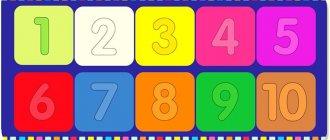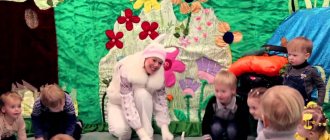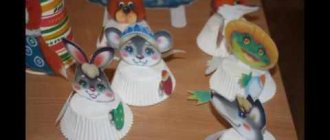Games by theme
- For preschoolers (senior and preparatory groups). Games with rules. Board games, card games, lotto, dominoes, construction sets, puzzles, checkers and chess...
- For young children (junior and middle groups). Development of fine motor skills and coordination, first acquaintance with color, shape and size. Choose by color, screw on the lid, insert a button, braid your hair, games with clothespins, lacing, find a pair, sensory mats and corners, collect beads, felt toys...
- REMP. Formation of ideas about number and quantity, size, shape. Development of spatial orientation, familiarity with time. Count, find the figure, determine the size, logic problems, counting sticks, geocont, tangram, puzzles, geometric lotto, abacus, clock...
- Formation of a sense of rhythm, development of musical perception, familiarity with notes. Musical instruments, homemade noise instruments, games with notes and sounds, musical corners.
- Acquaintance with folk art, artists and paintings. Development of aesthetic perception, color perception, familiarity with the rules of composition. Arts and crafts, patterns and ornaments, palette, drawing games, make a portrait, put together a landscape...
- Homemade baby books, albums, soft, tactile, lapbooks...
- Consolidating knowledge about natural objects and phenomena, animals and plants. Plants, animals, insects, planet Earth, weather, space, water, sand...
- parts of the day, routine and routine...
- Ecological (landscape), traffic regulations, historical, local history, seasonal...
- Traffic rules, signs, traffic lights, cars, street layouts...
- Development of breathing, articulation, formation of correct sound pronunciation, learning to read and write, sounds, letters. Automation of difficult sounds, exercises with sounds, letters and syllables, vowels and consonants, make up a word, games for breathing development...
- Development of coherent speech, grammatical and lexical structure. Based on literary works, based on reference pictures. Mnemonic tables We form adjectives, coordinate words, use prepositions, formulate questions, games based on fairy tales and literary works...
- Attributes and aids for role-playing games, accessories, clothing, furniture
- Do-it-yourself puppet, finger, tabletop and other types of theaters, masks. Theater corners.
- Carnival, theater, dance and other homemade costumes for children and adults
- Clarification of ideas about the Motherland, native land, its history, the Second World War. Regional component.
- Games of different nations. Games of our grandmothers, our childhood, round dance games.
- Invention games. We train analytical thinking, learn to identify, compare, and solve problems.
- Development of emotions, communication skills. Games for a good mood, little girls, for dating. Mood corners
- Active games outdoors and at home.
- Physical exercises, attributes, finger games.
- Sports and physical education corners, equipment for physical education, sports competitions, relay races. Massage paths
Bunnies (Ozon, My-Shop, KoroBoom)
This is a game that hooks children with almost 100% probability. Even if the kid doesn’t want to play by the rules, he will definitely enjoy putting together a fairytale field like a construction set and playing out simple stories on it. I think the main secret to the success of this board game is the 3D playing field, plus the interesting idea of harvesting in the garden.
To be honest, I bought this board game when my daughter was noticeably older than 2 years old (and she just stuck to it). But I’m including it in the selection of games for the little ones, because we took out the game many times when the kids came to visit, the game always went with a bang. Here the child only needs to count within three, the rules are also simple (only parents need to figure it out first, because the instructions are written quite intricately).
The main objective of the game is to go into the garden through a free hole in the fence and pick cabbage or carrots there (depending on the number of dots dropped). You need to quickly go home with your catch, and then go again for the next portion. Naturally, the winner is the one who reaps the most significant harvest.
Walking game “Visiting the Bunny” (with dice and chips)
I made this walker for my daughter when she was 2.5 years old. It became a wonderful help for us in mastering counting, and it just helped us have an interesting time together; my daughter simply adored the game. I recommend that you take this game into your arsenal, as it is made just for the little ones. You can read more about our walker and download it HERE.
Ready-made walkers for babies
If we talk about ready-made options available in stores, then “Cheese Run” (Ozon, Labyrinth, My-shop) seemed the most suitable for the role of the first walker. There are very few cells here - only 24, so the child definitely won’t have time to get tired. In addition, the kit includes a special cube for beginning accountants - the number of dots on it does not exceed three.
What I didn’t like about this board game is that it is not entirely clear to a novice player which direction to go now, all the cells are stuck together and therefore the direction is not obvious to the child.
Another good option is walkers from Umka (Ozon, My-shop, KoroBoom). The games are also simple and accessible, but there are significantly more cells, and the cube has very small dots, which presents some difficulty for a child who is just learning to count the cells and dots on the cube. So the games are more suitable for children who are seeing walkers not for the first time.
Games with cubes and chips are not the only thing that can be offered to a 2-year-old child. Here are some equally interesting options for board games for kids:
Handy materials
Can I ask your opinion? Friends, what material do you prefer for crafts?
I will probably express the general point of view that this is the one with which it is easier or more interesting for you to create something at home.
And I will voice one more point. Sometimes I don't take new or valuable material. Even junk is used. Something that is kept by chance, or in anticipation that I can make something useful out of it. For example, corks from plastic bottles or wine, an old chessboard whose pieces are lost, buttons, pebbles, etc.
Well, when we have gathered everything: an understanding of what we have to construct with the children, for what purpose and for what purposes. We found out what materials we could use. We didn't forget the good mood. Now all that remains is to get down to business.
Balancer scales
According to our observations, this board game for children also becomes interesting after 2.5 years. And again, the players take turns throwing a different-colored die here. Having thrown out, for example, red, the player must put a red cylinder on the scales. In this case, you need to be very careful not to drop either yours or the previously installed cylinders. The loser, naturally, is the one whose entire structure collapses. The balance beam develops clarity of movements, accuracy and, of course, also teaches you to play by the rules: it teaches you to wait your turn, and it also gives the child the understanding that not only he can win.
By the way, we have come up with another version of this game: you can not only stack the cylinders on the scales, but also build a tower out of them, also guided by the color that appears on the die.
Tips for choosing
A board game is usually perceived as a pretty good gift, but (like any other product) it can be chosen either well or inappropriately.
Since it is given so that the child receives useful skills of his own free will, and not when he is forced, it is very important that the child likes the game, so that he becomes interested in it and begins to play regularly
There are some simple tips on how to achieve your goal:
For a child, play is a holiday. Even if she makes him think deeply, he himself still gets pleasure not from the process of solving a complex problem, as in chess, but from the surroundings. For this reason, a board game for a small child should be bright and beautiful, and also involve a certain legend, reminiscent of an interesting fairy tale.
“Colorful caterpillars” (My-shop, Labyrinth, KoroBoom)
They have an excellent series of travel games that are compact and inexpensive. I would like to draw your attention to two games from this series - “Magic City” (pictured above) and “Colorful Caterpillars” (pictured below). Don't look at the fact that the box is marked 4+, it is clearly very overpriced. The games are perfect for children who are just starting to get acquainted with board games, because the rules here couldn’t be simpler.
“Caterpillars” and “Magic City” are very similar in essence. And although the rules contain several variants of the game, the process boils down to approximately the same - participants take turns throwing a multi-colored die and placing a piece of the corresponding color on their tower/caterpillar. The one whose design is longer or reaches a certain detail wins. Everything is simple and easy - just enough to get used to acting according to the rules.
Interesting for everyone
What you should pay attention to:
- age of the baby;
- interests;
- possibilities.
Why is it important? Because for some these will be exciting and developing projects, while for others they will be primitive, like completed material, which no one will like and which should not be allowed. Guys, do you know what is interesting to your little one personally? It would be good to take into account children's needs
Some people are crazy about trains, others need bunnies and monkeys. And others need to be taught how to count in a game or checked by traffic rules to see how much they know the rules, so that we remain calm when they go somewhere on their own
Guys, do you know what is interesting to your little one personally? It would be good to take children's needs into account as well. Some people are crazy about trains, others need bunnies and monkeys. And others need to be taught how to count in a game or checked by traffic rules to see how much they know the rules, so that we remain calm when they go somewhere on their own.
We are proud of our children! Their abilities are a reason for our little boast. And homemade strategy board games are a way to unlock a child’s potential and develop it.
Types of homemade board games
In our unified information space, it makes no difference who is the manufacturer of board games. The same development can be popular both in European countries and in America or Australia. Types of entertainment are varied, many classifications are closely related. For example, economic theory turns out to be not only a logic game, but also an exciting adventure, and popular walkers are nothing more than a carefully thought-out strategy.
Joint activities bring the family together; at this time you can discuss plans and problems along the way. PHOTO: market.yandex.ru
There are several classifications of board games that are suitable for a wide variety of companies and ages:
- for kids, their main task is development and learning, they teach the child to remember the names of geometric shapes, shapes and sizes;
- fillers or card board games are exciting activities with simple rules that are understandable to both adults and children;
- logical board exercises are aimed at developing thinking, building an interconnected chain of varying degrees of complexity;
- walkers are fairy-tale characters moving sequentially. The themes can be different, for example, horror films, colorful adventures;
- fighting games – they feature direct conflict. The game is played on or without a field, cards with different teams are involved;
- tabletop activities for friendly parties are specially designed for several participants;
- large strategic missions are intended for those with a lot of time;
- wargames are military-tactical battles with a huge number of miniatures, fairly complex rules and a mandatory field.
Having chosen the theme, age and number of participants, you can start making it yourself.
Strategic battles for adults can be designed to hold several tournaments over a long period of time. PHOTO: tdko.su





